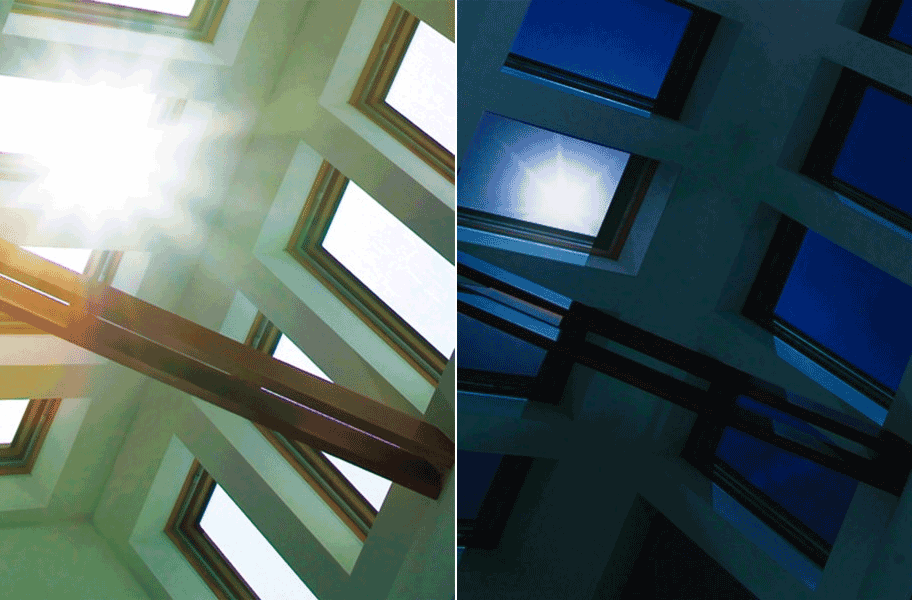Blog Post
High-Tech Windows with Dynamic Glazings

Last week I wrote about one of the innovative building materials that I saw at this year's Greenbuild Conference in Phoenix (phase-change drywall). This week, I'll cover a very different innovation from the conference: dynamic window glazing.
Windows provide some important functions in houses: admitting natural daylight, allowing views to the outdoors, letting in fresh air, and protecting against unwanted heat loss and gain. How effectively they do all this depends mostly on the glazings (usually glass, but sometimes plastic, or a combination of glass and plastic). Energy performance can be significantly improved by adding multiple layers of glazing separated by sealed air spaces, by using special low-emissivity (low-e) coatings on the glazing, by using tinted glass that blocks unwanted solar heat gain, or by using low-conductivity gas fill, such as argon and krypton, that slows the movement of heat through the space between layers of glass.
The problem is that when you choose a particular glazing for windows, you're locked into very specific window performance properties. Tinted glass, for example, not only blocks solar heat gain, but also reduces visible light transmittance--making it harder to see through the windows. Blocking that solar gain may be fine most of the time, but even in warm climates there can be times, in the winter for example, when you'd like to bring in that extra solar heat.
This lack of flexibility with the usual materials has led some companies to pursue technologies that would allow glazing properties to change, based either on user preferences or on conditions such as temperature. These are collectively referred to as "dynamic glazings."
There were a number of dynamic glazings being exhibited at Greenbuild. I was already familiar with SageGlass, from Sage Electrochromics. This is an "electrochromic" glazing that is normally clear, but it can be tinted by charging it with a small amount of electric current. When SageGlass is used in an insulated glass unit (with standard clear glass), a user can flip a switch, to tint the glass, dropping the solar transmittance from 62% down to 3.5%. It takes a small amount of electricity, about 0.3 watts per square foot, to switch it from clear to tinted (a process that takes 5-10 minutes), then somewhat less current, 0.1 watts per square foot, to maintain the tinted state. When the current flow is switched off, the glazing reverts to it default (clear) state.
SageGlass is available as an (expensive) option with Velux skylights and about a dozen commercial glazing systems. The high cost of SageGlass can be offset to some extent, particularly in commercial applications, by eliminating the need for widow blinds, but it's still very expensive--$50-75 per square foot.
SUPPORT INDEPENDENT SUSTAINABILITY REPORTING
BuildingGreen relies on our premium members, not on advertisers. Help make our work possible.
See membership options »The new dynamic glazing product I saw at Greenbuild was from the start-up company RavenBrick. This is a passive, "thermochromic" glazing that changes from clear to tinted when it heats up, such as in bright sunlight. While SageGlass is a metallic coating on the glass, like common low-e coatings, RavenBrick uses an organic material sandwiched between two layers of glass. The actual thermochromic material is only eight microns thick.
Clear in its normal state, when the RavenBrick coating is heated up it darkens to allow only 8% light transmission. The idea is that during a hot sunny day, the glass will heat up and activate the thermochromic material, blocking most of the sunlight, while on a cooler or cloudy day, the glass will remain clear. A big advantage is that it doesn't take any electricity to activate or maintain the tinting, as is necessary with SageGlass, but the down side is that it isn't controllable by building occupants.
There may be times when you want sunlight in the building or views to the outdoors even when significant heat gain will occur. Also, there may be some weird results if there's a shadow on a portion of a window, resulting in only part of the glass being darkened.
The company claims that the product will become available in March 2010, and they are providing prototype glazing for an installation at the National Renewable Energy Laboratory in Golden, Colorado. As with SageGlass, RavenBrick will sell product to window manufacturers, rather than producing windows themselves. RavenBrick's president told me that the cost will be about $25 per square foot--somewhat lower than SageGlass. It could be a great product; I'll be watching the test installation carefully.
I invite you to share your comments on this blog. You can also follow my musings on Twitter.
Published December 1, 2009 Permalink Citation
(2009, December 1). High-Tech Windows with Dynamic Glazings. Retrieved from https://www.buildinggreen.com/blog/high-tech-windows-dynamic-glazings



Add new comment
To post a comment, you need to register for a BuildingGreen Basic membership (free) or login to your existing profile.